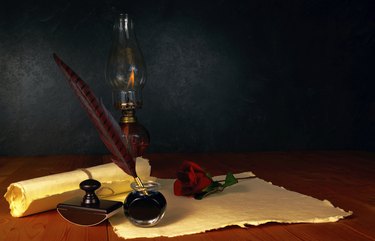
Overlaying a picture with the text from a poem is easy to do with modern computer software. Just open the picture in an image editor, set it up the way you want it and then use the editor's text tool to add the text of the poem. You can produce a beautiful finished result with relatively little effort, and the artistic choices you make can cover a wide range of emotions.
Choose an Image Editing Program
Video of the Day
To combine the poem with your picture, you need an image editing program. You can use Paint, which comes with Windows, free software like GIMP or Paint.NET, or paid software like Photoshop or Paint Shop Pro. Overlaying text onto an image is easy, so you don't need a full-featured, robust program. Just pick the one you're most comfortable using.
Video of the Day
Set Up the Picture
Before you add the poem, open the picture in your graphics editor. Use the "Save As" feature to create a copy of your picture so that you'll still have the original if you need it. Then you can make any changes you want, such as cropping or resizing the picture, changing the contrast and brightness levels and sharpening or blurring the image clarity.
Set Up the Text
Once your picture appears the way you want it, you're ready to set the font, size and color of your text. With different fonts, you can evoke different moods, and by controlling the size of the text you can strike a balance between showcasing the picture itself and drawing attention to the poem. When you're ready to add the text, all you have to do is click the text icon.
Choose the Text Color Carefully
The text color you pick is especially important. Choose a color that will make the text stand out against the picture clearly and legibly. Bright or white text goes well over dark areas of a picture, and dark text goes well over the bright areas. If your picture doesn't have enough consistency, then you can add dark borders, sometimes called "strokes," around your font's bright letters -- or vice versa -- so that no matter how bright or dark the underlying picture is the text will still be legible. Adding borders may not be so easy in some text editors, so, alternatively, you can use the image editor's shape generator to create a simple, mono-color rectangle or oval underneath the area where you want your text, and then type the text on top of it. This obscures some of the picture, but used carefully it can produce a nice effect.